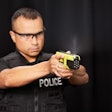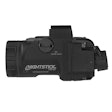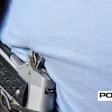Many police hierarchies operate under the erroneous assumption that their organizations don't need sniper units. Normally, this position is adopted as a result of not understanding the many roles snipers units can perform. The preponderance of police supervisors and officers believe that the only role snipers play is the neutralization of a perpetrator through the mechanics of a single-precision rifle shot. These perceptions are correct, however, a sniper's role extends far beyond the placement of a precision shot.
Multiple Functions
Though sniper duties are specialized, they are also flexible and adaptable to a variety of valuable tactical roles.
Engaging targets of opportunity involves snipers positioned in an area that is known to be occupied by a perpetrator. These snipers are given the order to fire on the perpetrator the moment he moves into the snipers' field of fire. This situation normally evolves after all other efforts (talk, smoke, chemical agents, etc.) have failed to resolve the situation.
Targets of opportunity orders should be tightly controlled, and only applied under the most exigent of circumstances following all department use-of-force policy guidelines.
Perimeter defense requires the sniper to supplement cordon forces by performing the duties of protecting the inner and outer perimeters. Snipers can provide cover fire focused on potential avenues of approach or escape from a distance. Just the knowledge or belief that snipers are on the perimeter may prevent the perpetrator from trying to escape.
Resolving hostage situations requires the sniper to eliminate the perpetrator during a crisis involving hostages. Long-range (beyond the traditional distances of handguns, shotguns and carbines), accurate weapons fire may be the only practical way to end this type of situation.
Counter sniper operations are best performed by officers trained in sniper operations. Snipers know what their adversary is thinking in terms of tactics and can generally predict likely firing positions, avenues of approach, avenues of escape, desirable targets, etc. Counter sniper operations consist of a deadly game of "cat and mouse" which should only be played by equals. An untrained officer trying to "ferret out" a trained or even a novice sniper will most likely be killed.
Snipers are useful for providing fire from positions of relative safety. Since snipers can locate and eliminate perpetrators from a distance, they can provide protective fire for responding forces, tactical teams, wounded officers, released hostages, hostage negotiators, delivery personnel, medical personnel, fire department personnel, police helicopters, and any other authorized entity involved in the tactical operation.
Information collection through reconnaissance efforts is probably the sniper's main role. Police supervisors unfamiliar with sniper capabilities often overlook this extremely valuable source of tactical information. Snipers are often among the first tactical officers to reach the scene and are normally located in positions from which they can collect information concerning the perpetrator, target area, and adjacent tactical arena.
Snipers may be tasked with performing certain support functions or asked to gather the following elements of essential information:
1. Identify reconnaissance routes, ingress and egress routes which provide covered and concealed routes to and from the target area, and high-speed of essential information.
2. Identify observation points that supervisors and officers can use to survey the tactical arena without being compromised (discovered) and estimate the amount of the tactical arena the perpetrator can see from his position.
3. Take still photographs or video of the target area, adjacent tactical arena, and hostages or perpetrators.
4. Specify resting points or rally points, areas where tactical teams can take advantage of cover and concealment while resting, re-grouping, or discussing conduct of operation changes during a lengthy operation.
5. Identify danger areas as possibly under adversary observation or field of fire.
6. Evaluate environmental, safety and health considerations. These considerations may make a tactical problem worse, if they are ignored. For example, an area inside an industrial building may contain a volatile substance that, if shot, may cause mass contamination, fire or explosion.
7. Establish evacuation routes so that snipers can provide cover fire for retreating officers or for hostage control, once release is negotiated.[PAGEBREAK]
8. Establish the most suitable areas for containment forces, tactical operation center (TOC) locations, and field command post (FCP) locations.
9. Identify utility locations. There may be a request for snipers to disable a utility, for example, a transformer or a perimeter light (normally by using a suppressed weapon or pellet rifle). Or other tactical operators may need to know the location of utilities for operational considerations.
10. Identify key terrain that has tactical value. Examples include high ground, areas controlling the terrain, areas allowing good fields of fire or observation, etc. These areas need to be controlled by snipers of tactical entities, other than the perpetrators.
11. Evaluate cover and concealment. Does the tactical arena contain areas providing good cover and concealment for all entities involved?
12. Evaluate communications. Quite often, tactical arenas will contain dead spots (areas where radios will not transmit or receive). When these areas are discovered, the information must be passed on to all units involved so that other types of communications can be developed.
13. Identify physical protection systems, such as alarm systems, closed circuit televisions, lighting, guard dogs, fences, and any hardened areas. Ironically, physical protection systems designed to protect an area may actually assist perpetrators after a breach has occurred. A perpetrator may use physical protection devices as early warning devices that SWAT operators are moving into the area. Physical protection systems may require sniper neutralization or team circumvention.
14. Perform range estimations for priority features located in the target area. For example, windows, doors, stairs, parked vehicles, observation points, high speed avenues of approach or escape, obstacles, etc. These predetermined ranges allow tactical operations to establish "time hacks" used for the timing of the operation.
15. Perform other tactical team duties. If the situation does not lend itself to the efficient use of snipers, they may be assigned to other tactical team duties. There is no reason for supervisors to relegate snipers to rigid, narrowly defined duties. Indeed, many departments do not have an unlimited source of manpower to expend in lock-step fashion. Flexibility is the key to successful tactical operations and snipers may be the most flexible of all SWAT team members.
The exact way in which snipers are employed is governed by many factors, but if snipers are to be employed effectively, police supervision must have a sound grasp of the tactical situation and a total undertaking of the sniper units' capabilities.
A Job For a Team
Because of the number and intensity of tasks that snipers must perform, it is extremely difficult for one sniper to operate alone. If a single sniper is deployed in a tactical crisis, he has to divide his attention among the tasks of observation, communication, and marksmanship. This lone sniper must also be concerned with his own physical security. The lone sniper may be able to perform all of these tasks to marginal standards for a short period of time, but the physical and mental strain will be tremendous. Fatigue will have a detrimental effect on all assigned tasks during an extended operation.
To prevent fatigue, snipers are nest deployed in teams of two individuals, playing the roles of sniper and observer. Both snipers should be equally equipped and trained. One sniper will devote his attention to marksmanship duties, while the other sniper concentrates on observation, reporting, target identification, and position security duties. Snipers should routinely alternate duties to further reduce fatigue.
A sniper's flexibility and ability to provide numerous operational functions should make police hierarchies take note, especially in this day and age of tight budgets. Police supervision should avoid the mistake of relegating snipers to the precision-shot role through limited or inadequate training. Supervisors should expand the sniper units to envelop and reap the myriad of tactical capabilities available.
Based in Piketon, Ohio, Tony Jones has more than 15 years of experience in SWAT operations and nuclear security. Founder of Heightened Vigilance, a tactical/security consulting company, Jones is an occasional contributor to POLICE.











